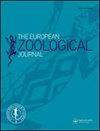阿尔卑斯两个相邻城市白纹伊蚊的多年动态
IF 1.6
4区 生物学
Q2 ZOOLOGY
引用次数: 0
摘要
摘要入侵性虎蚊白纹伊蚊由于其叮咬性和潜在的疾病传播潜力,对人们来说是一种严重的公害,即使在意大利山区也是如此。在这项工作中,我们研究了它在两个相距仅25公里的阿尔卑斯山城市Rovereto和Trento首次入侵时的发生动态。从5月中旬到10月底,使用诱蚊产卵器对蚊子的分布进行了评估,从首次报告的蚊子发生开始,即2001年在Rovereto和2010年在Trento。在这两个城市,诱蚊有七种栖息地类型:聚集地、住宅区、城市公园、停车场、水道附近、工业区和农田。2001年至2020年,这两个城市的年平均气温和降水量相似。我们曾假设,两个城市之间卵子数量的季节和年度差异将是有限的。在这两个城市,鸡蛋的平均数量与气温之间存在显著的线性和正相关关系,但特伦托的斜率更大。此外,特伦托的每个诱蚊产卵器的平均卵数高于罗韦雷托(平均50.3个对14.2个)。没有任何考虑的风险因素(气候、栖息地类型)解释城市之间的这种丰度差异。事实上,根据温度,预计在2010-2020年期间,特伦托的卵子会比罗韦雷托少(激活诱捕器期间的平均温度分别为19.2°C和19.7°C)。因此,我们认为其他人为因素,如不同的控制活动(仅在罗韦雷托进行了通奸处理),也许可以解释城市之间鸡蛋丰度的差异。评估治疗效果的特定实验设计可能会验证我们的假设(例如,在监测期间使用杀伪剂,在距离诱蚊产卵器有一定距离的地方进行治疗,并以特定的周期比较成虫和卵子的丰度)。亮点白纹伊蚊入侵相隔25公里的两个高山城市,滞后12年。这两个城市的卵子丰度的时间趋势与温度呈正相关。白纹伊蝇在城市地区的聚集地更为丰富。较冷的城市(特伦托)受感染程度更高。在罗韦雷托进行的控制活动可能解释了这两座城市之间丰度的差异本文章由计算机程序翻译,如有差异,请以英文原文为准。
Multi-year dynamics of the Aedes albopictus occurrence in two neighbouring cities in the Alps
Abstract The invasive tiger mosquito Aedes albopictus is a serious nuisance for people due to its biting and potential for disease transmission, even in Italian mountain regions. In this work, we examined its occurrence dynamic from the first invasion in two Alpine cities, Rovereto and Trento, only 25 km apart. Mosquito’s distribution was assessed using ovitraps, from mid-May to end-October, from its first reported occurrence, i.e. 2001 in Rovereto and 2010 in Trento. In both cities, ovitraps were located in seven habitat types: gathering places, residential areas, urban parks, car parks, near watercourses, industrial areas and croplands. The annual average temperature and precipitation were similar in the two cities from 2001 to 2020. We had hypothesized that the seasonal and annual differences in egg number between both cities would be limited. Significant linear and positive relationship was found between the average number of eggs and air temperature in both the cities, but with a steeper slope in Trento. In addition, the average number of eggs per ovitrap was higher in Trento than in Rovereto (average 50.3 vs 14.2). None of the considered risk factors (climate, habitat type) explained such difference in abundance between cities. Indeed, based on the temperature, the expectation was to find fewer eggs in Trento being cooler than Rovereto during 2010–2020 (the average in the period of activated traps was, respectively, 19.2 vs 19.7°C). Thus, we argue that other anthropogenic factors, such as different control activities (adulticide treatments were carried out solely in Rovereto), might explain the difference in egg abundance found between cities. A specific experimental design to evaluate treatment effect might validate our hypothesis (e.g. apply adulticides during the surveillance period, with treatments applied at regular distances from the ovitraps and with a specific periodicity to compare adult and egg abundance). Highlights Ae. albopictus invaded two alpine cities 25 km apart with a lag of 12 yrs Temporal trend of egg abundance was positively correlated with temperature in both cities Ae. albopictus was more abundant in gathering places in urban areas The colder city (Trento) was the more infested Control activities carried out in Rovereto might explain difference in abundance between the two cities
求助全文
通过发布文献求助,成功后即可免费获取论文全文。
去求助
来源期刊

European Zoological Journal
Agricultural and Biological Sciences-Animal Science and Zoology
CiteScore
3.10
自引率
5.60%
发文量
80
审稿时长
30 weeks
期刊介绍:
The European Zoological Journal (previously Italian Journal of Zoology) is an open access journal devoted to the study of all aspects of basic, comparative and applied protozoan and animal biology at molecular, cellular, tissue, organ, organismal, population, and community-ecosystem level. Papers covering multiple levels of organization and integrative approaches to study animal form, function, development, ecology, evolution and systematics are welcome. First established in 1930 under the name of Il Bollettino di Zoologia, the journal now has an international focus, reflected through its global editorial board, and wide author and readership.
 求助内容:
求助内容: 应助结果提醒方式:
应助结果提醒方式:


